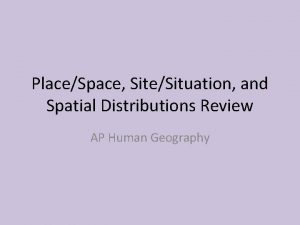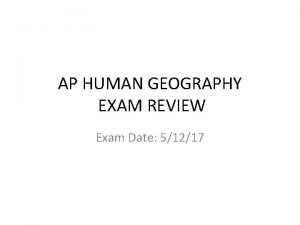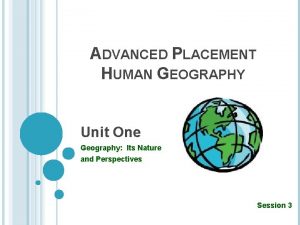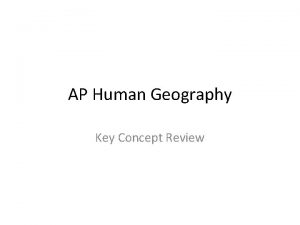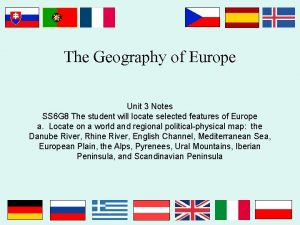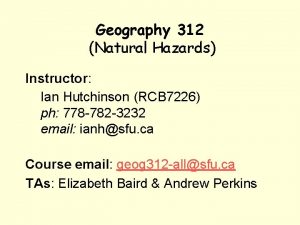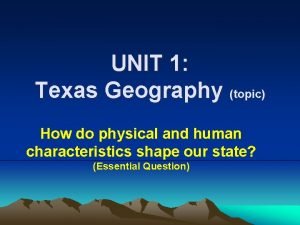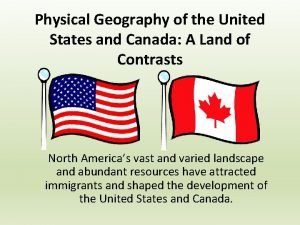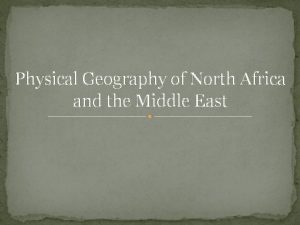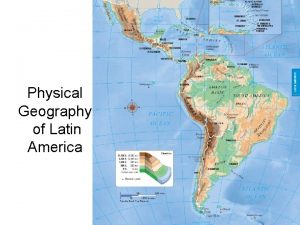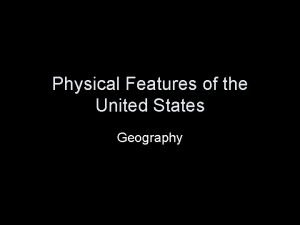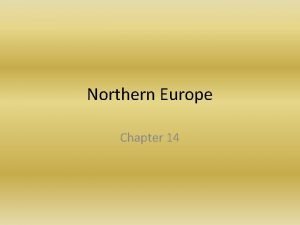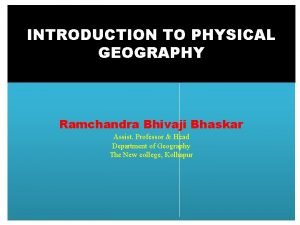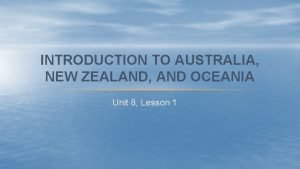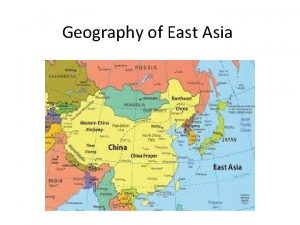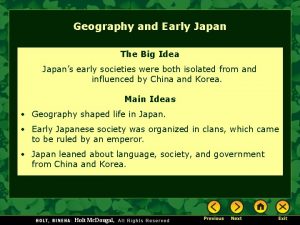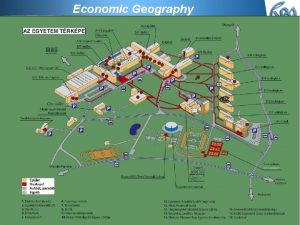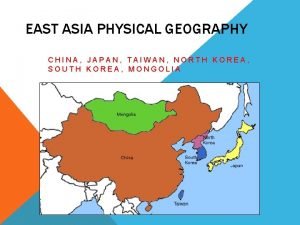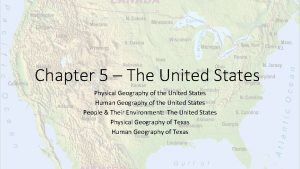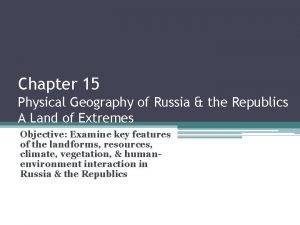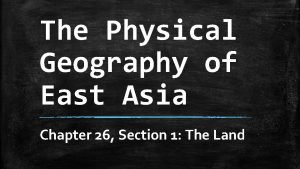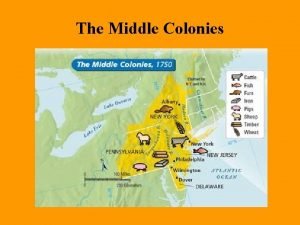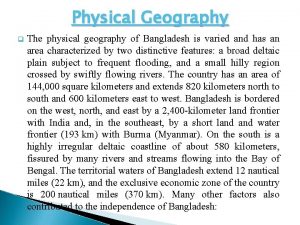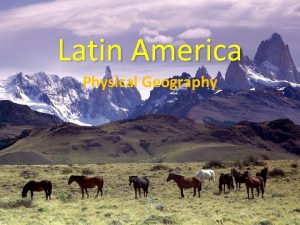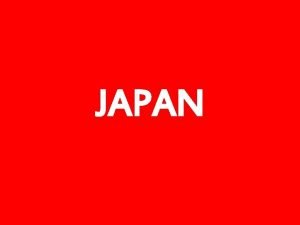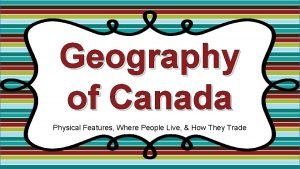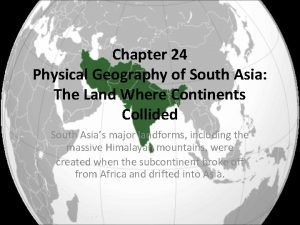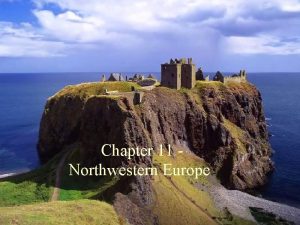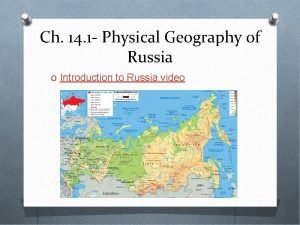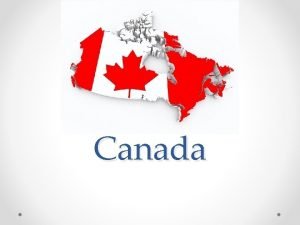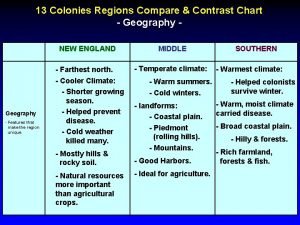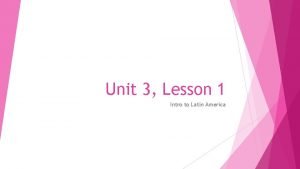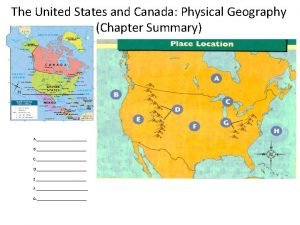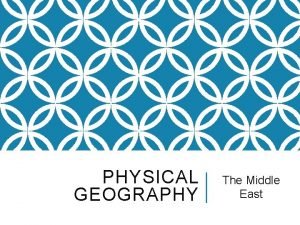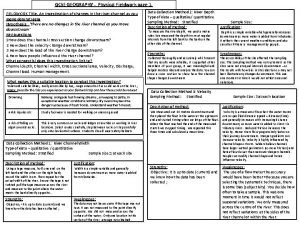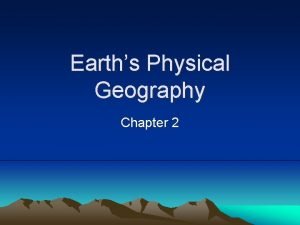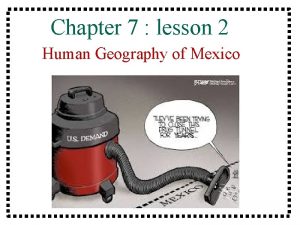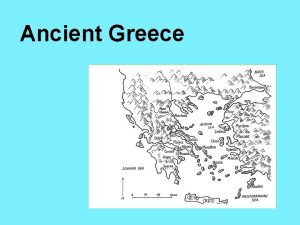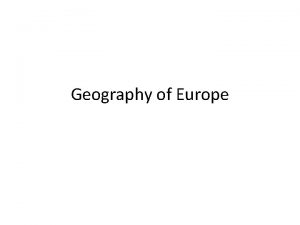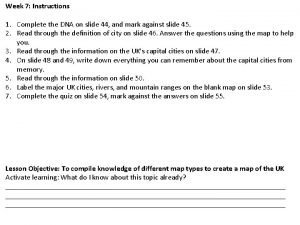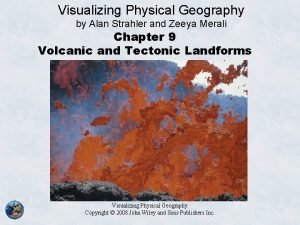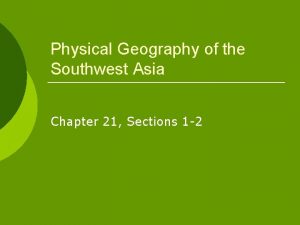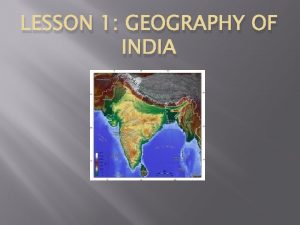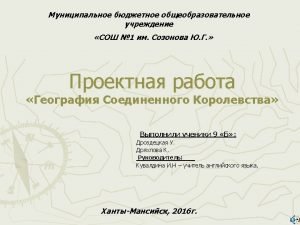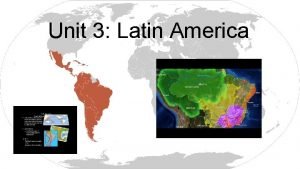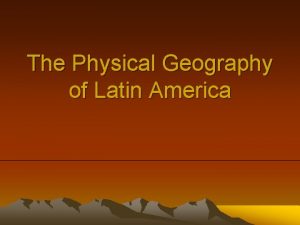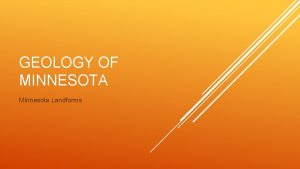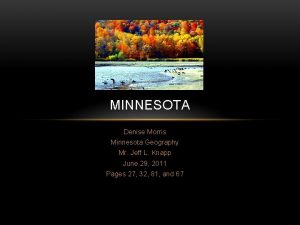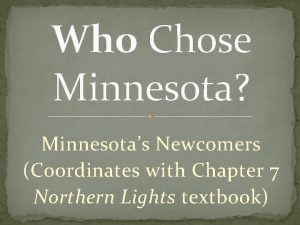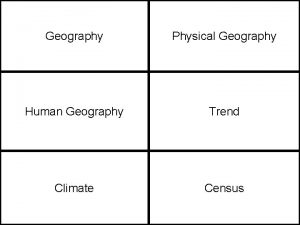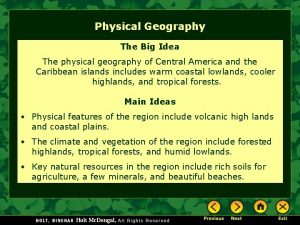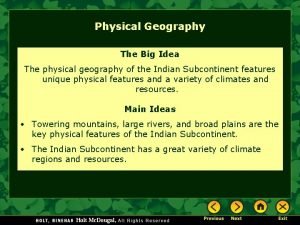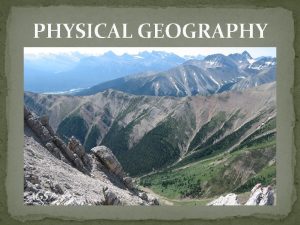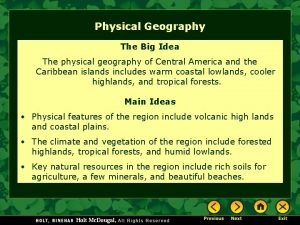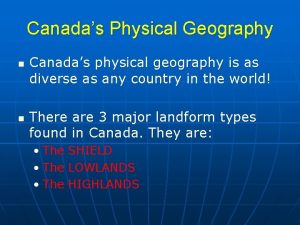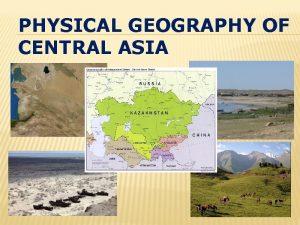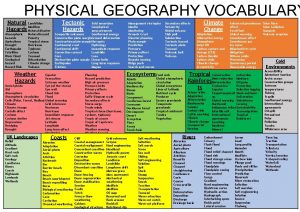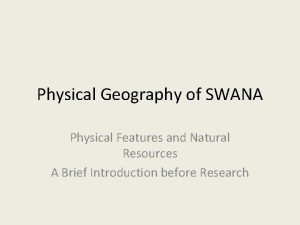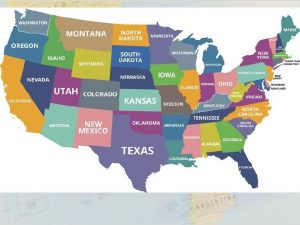MN Physical Geography Minnesota from Space Minnesotas Natural





































































- Slides: 69

MN Physical Geography

Minnesota from Space

Minnesota’s Natural Boundaries

Northwest Angle

Minnesota’s Topography

(Elevation) Minnesota Relief

Eagle Mountain Highest Point in MN (2, 301’)

Minnesota’s Glaciers • 4 continental glaciers advanced and retreated across MN • The Pleistocene ice age was the most recent and covered most of MN • Along the way glaciers picked up rocks and soil and transported it to the south

Minnesota’s Glaciers • The rocks and soil left behind known as “glacial drift” • The melting also left behind many shallow lakes • Soils left behind are an “unsorted” mixture of soil, rocks and pebbles

Glacier’s Southern Edge

Canadian Shield • Physical region of mostly bare bedrock and little topsoil • Covers much of central Canada, northeastern MN and northern Wisconsin

Glacial Abrasion

“Ice-Scoured” Surface Most of the Arrowhead region is “ice-scoured”

Boundary Waters Canoe Area • Much bare bedrock • Soil pushed to the south by glaciers • Little soil left behind is thin and rocky

(Elevation) Minnesota Relief

Glacial Moraines are belts of hills that form at the edges of melting glaciers when boulders, stones and soil accumulates Glacial Lakes Moraine

MN Moraine Belts • Glaciers moved across “Moraine and Lakes” region of central MN several times leaving many moraines • Region is hilly with many shallow lakes Moraine and Lakes

Moraine and Lakes Region • This region is covered by “Glacial drift” (soil, rocks, sand pebbles) deposited on the land when glaciers melted • Region is hilly with many shallow lakes • Flattest areas are “outwash plains”

MN Moraines Monticello’s “Little Mountain” Powder Ridge

Buffalo Ridge (Elevation) Minnesota Relief

Buffalo Ridge

Driftless Area (Elevation) Minnesota Relief

Glacier’s Southern Edge

Driftless Area • SE MN is described as “Driftless” because it was never touched by glaciers

Driftless Area • Driftless area has no glacial drift • Few lakes and many rivers and streams • Millions of years of erosion visible

(Elevation) Minnesota Relief Red River Valley

Minnesota’s 3 Continental Divides • A continental divide is a high point of land separating the direction rivers flow • Most of southern MN’s water drains into Mississippi and Gulf of Mexico • Much of Arrowhead drains into Lake Superior eventually reaching Atlantic • NW MN drains north to Lake Winnipeg and Hudson Bay Laurentian Divide

Laurentian Divide From Lookout Mountain

MN’s Glacial Lakes iz s s e k a a g A L th k ulu D e La Bro w n’s Val ley Lake Minnesota

Glacial Lake Agassiz • When last glacier melted the drainage path of the melt water was blocked • Lake Agassiz formed until glacier melted • Overflow created Minnesota River • Sediments settled to the bottom filling in low spots and creating an extremely flat surface

Red River Valley • Red River Valley is an extremely flat area that was once covered by Lake Agassiz • Sediments fell to bottom creating thick and sticky soils known as “gumbo”

Red River of the North • Why is the path of the Red River Valley so crooked? • The land is so level the river struggles to find a consistent downhill slope

Red River of the North Downtown Moorhead/Fargo

Moorhead Floods Spring 2009

lley Red River Va MN’s Physical Regions d Bu a he w ro r A ffa Moraine and Lakes lo Ri d Dr if ge tle s s

MN Topography

Minnesota’s Climate

Minneapolis Climate Humid Continental Wide ranges in temperatures

MN Temperatures Hot Summers and Cold Winters

MN Precipitation • Most of the moisture that falls in MN comes from Gulf of Mexico • Precipitation greatest in the SE and least in the NW m J ea r t S et

4 Distinct Seasons March 29, 1881

MN Growing Season Consecutive Days Averaging 43 o. F or More Only southern MN has a long enough growing season for corn

Minnesota’s Natural Vegetation

MN Natural Vegetation

Coniferous Forests

Deciduous Forests

Prairie

MN Natural Vegetation • Natural vegetation is an indicator of a region’s precipitation, temperatures and soil • NE MN mostly coniferous forest • Central MN mostly deciduous • S & W MN mostly prairie

Percent of MN in Commercial Forests 70% of MN’s commercial forest industry located in NE MN

Natural Soil Fertility

MN Soil Fertility • Best soils are found in the southern and western MN • Least fertile soils are found in northeast MN (thin, rocky and acidic podzol soils)

Minnesota’s Natural Regions

iry Da lt Be er Va v i R d e R lley MN Natural Vegetation Arrowhead Corn Belt

Red River Valley MN’s Natural Regions Arrowhead Da iry Be Corn Belt lt

MN Topography


Natural Soil Fertility

Arrowhead Percent of Land in Farms

Arrowhead • Ice-scoured by glaciers • Thin and rocky soils • Cool temps and short growing season • Coniferous forest • Podzol (acidic) soils • Little agriculture • Much land remains in forests • Paper, mining and tourism impotant economic activities

Red River Valley MN’s Natural Regions Arrowhead Da iry Corn Belt Be lt

Dairy Belt • Hilly topography • Glacial moraines • Many lakes and marshes • Soil better than Arrowhead but not as good as the Corn Belt • Most farmers raise livestock, particularly dairy cattle

Red River Valley MN’s Agricultural Regions Arrowhead Dairy Belt Corn Belt

Red River Valley Percent of Land in Farms

Red River Valley • Once the bottom of glacial Lake Agassiz • Extremely flat • Spring floods common • Thick and sticky “gumbo” soils • Soils are soil to dry in the spring • Short growing season

Red River Valley MN’s Natural Regions Arrowhead Dairy Belt Corn Belt

Percent of Land in Farms Corn Belt

Corn Belt Buffalo Ridge Rock County

Corn Belt • Relatively flat topography except “Buffalo Ridge” in southwest corner • Thick, black soils • Long growing season • Adequate precipitation • One of the best agricultural regions in the nation

lley a V r e v i Red R MN’s Agricultural Regions Arrowhead iry Da lt Be Corn Belt
 Ap human geography political geography frq
Ap human geography political geography frq 5 themes of geography ap human geography
5 themes of geography ap human geography Ap human geography political geography test
Ap human geography political geography test Time space convergence example ap human geography
Time space convergence example ap human geography The arrangement of a phenomenon across earth's surface is
The arrangement of a phenomenon across earth's surface is Example of pop culture
Example of pop culture Time space compression ap human geography
Time space compression ap human geography Industrial revolution definition ap human geography
Industrial revolution definition ap human geography Natural boundary ap human geography
Natural boundary ap human geography Natural hazards definition ap human geography
Natural hazards definition ap human geography Joint space vs cartesian space
Joint space vs cartesian space Space junk the space age began
Space junk the space age began Camera space to world space
Camera space to world space Cartesian space vs joint space
Cartesian space vs joint space World space computer
World space computer Natural hazards vs natural disasters
Natural hazards vs natural disasters Natural income
Natural income Physical differences in the workplace
Physical differences in the workplace Physical geography of texas
Physical geography of texas Physical geography of us
Physical geography of us North africa physical geography
North africa physical geography Physical geography of latin america worksheet answers
Physical geography of latin america worksheet answers What are the major physical features of the united states
What are the major physical features of the united states Physical geography
Physical geography Latin america webquest worksheet answers
Latin america webquest worksheet answers Branch of geography
Branch of geography Lesson 1 physical geography of australia and new zealand
Lesson 1 physical geography of australia and new zealand Asia geography
Asia geography Branches of human geography
Branches of human geography Japans physical geography
Japans physical geography Document
Document Physical geography of east asia
Physical geography of east asia Physical geography of the united states
Physical geography of the united states China population density
China population density Chapter 15 physical geography of russia and the republics
Chapter 15 physical geography of russia and the republics Lesson 1 physical geography of southeast asia
Lesson 1 physical geography of southeast asia Definition of eastern europe
Definition of eastern europe Physical geography of east asia
Physical geography of east asia Physical geography of the middle colonies
Physical geography of the middle colonies Geography of bangladesh
Geography of bangladesh Glaciation left hundreds of thousands of
Glaciation left hundreds of thousands of Physical geography of latin america
Physical geography of latin america Japan physical geography
Japan physical geography Canada physical features
Canada physical features South asia physical geography
South asia physical geography Physical geography of northwestern europe
Physical geography of northwestern europe Chapter 14 the physical geography of russia answers
Chapter 14 the physical geography of russia answers 90 of the canadian population lives within
90 of the canadian population lives within Ancient japan geography
Ancient japan geography Economy of the 13 colonies chart
Economy of the 13 colonies chart Lesson 1 physical geography of south america
Lesson 1 physical geography of south america Physical systems geography definition
Physical systems geography definition Define landform
Define landform Physical geography of middle east
Physical geography of middle east Stratified sampling physical geography
Stratified sampling physical geography Earth's physical geography chapter 2
Earth's physical geography chapter 2 Chapter 7 lesson 2 social studies
Chapter 7 lesson 2 social studies States west of the mississippi
States west of the mississippi Kums definition geography
Kums definition geography Physical geography greece
Physical geography greece Physical map definition geography
Physical map definition geography Physical geography of rome
Physical geography of rome Uk physical geography
Uk physical geography Shield volcano
Shield volcano Chapter 8: the physical geography of latin america answers
Chapter 8: the physical geography of latin america answers Chapter 21 physical geography of southwest asia
Chapter 21 physical geography of southwest asia Countries in the indian subcontinent
Countries in the indian subcontinent Uk physical geography
Uk physical geography Amazon river
Amazon river South america highlands
South america highlands



